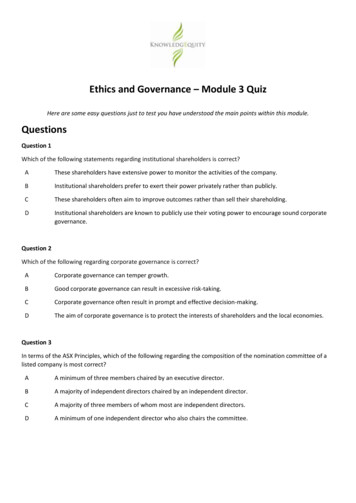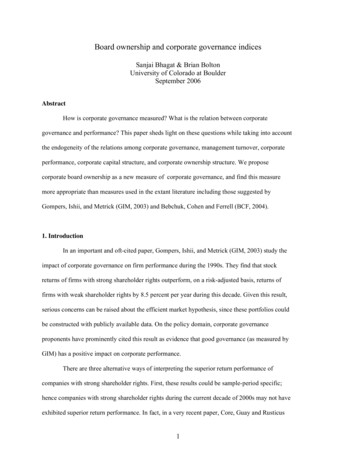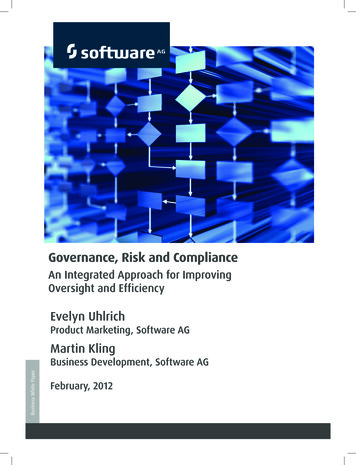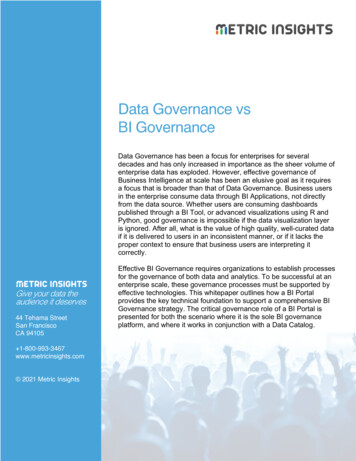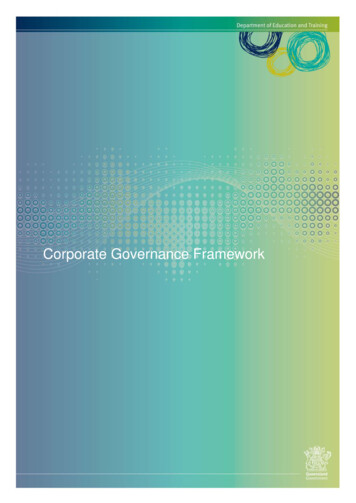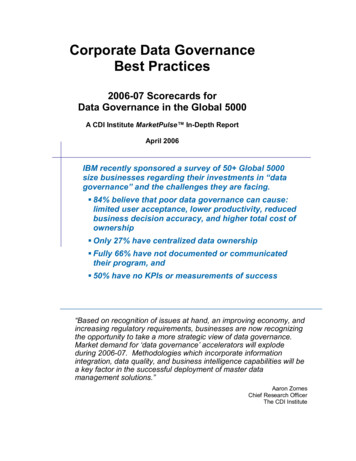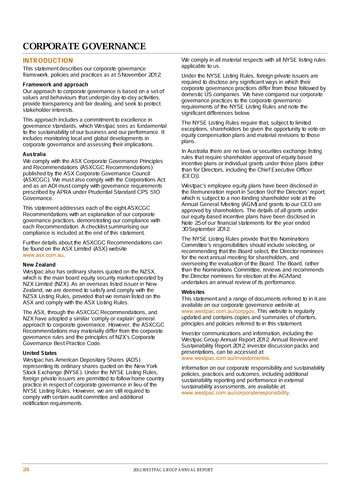
Transcription
ASX Corporate Governance CouncilCorporate Governance Principlesand Recommendations3rd EditionASX Corporate Governance Council
DisclaimerAlthough Council members and their related bodies corporate (“Council”) have made every effort to ensurethe accuracy of the information as at the date of publication, the Council does not give any warranty orrepresentation as to the accuracy, reliability or completeness of the information. To the extent permittedby law, the Council and their respective employees, officers and contractors shall not be liable for any lossor damage arising in any way, including by way of negligence, from or in connection with any informationprovided or omitted or from any one acting or refraining to act in reliance on this information. Copyright 2014 ASX Corporate Governance Council.Actuaries Institute ACN 000 423 656, Association of Superannuation Funds of Australia, ACN 002786 290, Australian Council of Superannuation Investors, Australian Financial Markets Association ACN119 827 904, Australian Institute of Company Directors ACN 008 484 197, Australian Institute ofSuperannuation Trustees ACN 123 284 275, Australasian Investor Relations Association ACN 095 554153, Australian Shareholders’ Association ACN 000 625 669, ASX ABN 98 008 624 691, BusinessCouncil of Australia ACN 008 483 216, CPA Australia ACN 008 392 452, Financial Services CouncilACN 080 744 163, Financial Services Institute of Australasia ACN 066 027 389, Governance Instituteof Australia ACN 008 615 950, Group of 100, Institute of Public Accountants ACN 004 130 643, TheInstitute of Chartered Accountants in Australia ARBN 084 642 571, The Institute of Internal Auditors Australia ACN 001 797 557, Law Council of Australia ACN 005 260 622, Property Council of AustraliaACN 008 474 422, Stockbrokers Association of Australia ACN 089 767 706. All rights reserved 2014.
ContentsForeword2About the Council2What is “corporate governance”?3The purpose of the Principles and Recommendations3The basis of the Principles and Recommendations –the ‘if not, why not’ approach3The application of the Principles and Recommendations4The structure of the Principles and Recommendations4The linkage with ASX’s Listing Rules5Where to make corporate governance disclosures6Disclosing the fact that a recommendation is followed6Disclosing the reasons for not following a recommendation7Effective date7Acknowledgments7Principle 1: Lay solid foundations for management and oversight8Principle 2: Structure the board to add value14Principle 3: Act ethically and responsibly19Principle 4: Safeguard integrity in corporate reporting21Principle 5: Make timely and balanced disclosure24Principle 6: Respect the rights of security holders25Principle 7: Recognise and manage risk28Principle 8: Remunerate fairly and responsibly31The application of the recommendations to externallymanaged listed entities35Glossary371
ForewordThe ASX Corporate Governance CouncilPrinciples and Recommendations (“Principlesand Recommendations”) were introducedin 2003. A substantially re-written secondedition was released in 2007 and newrecommendations on diversity and thecomposition of the remuneration committeewere added in 2010.Since the release of the second edition in2007, there has been considerable focusacross the world on corporate governancepractices in light of the events leading upto, and during, the Global Financial Crisis.In response, a number of jurisdictions haveadopted new legislation regulating corporatebehaviour and/or upgraded their corporategovernance codes.Following a comprehensive review in 201213, the 21 members of the ASX CorporateGovernance Council (“Council”) agreed thatit was an appropriate time to issue a thirdedition of the Principles and Recommendations.The changes in the third edition reflect globaldevelopments in corporate governancesince the second edition was published.The opportunity has also been taken tosimplify the structure of the Principles andRecommendations and to afford greaterflexibility to listed entities in terms of where theymake their governance disclosures.Alan Cameron AOChair, ASX Corporate Governance Council27 March 2014About the Council2The Council was convened in August 2002. Itbrings together various business, shareholderand industry groups, each offering valuableinsights and expertise on governance issuesfrom the perspective of their particularstakeholders. Its primary work has beenthe development of the Principles andRecommendations.Business Council of AustraliaThe members of the Council are:Institute of Chartered Accountants AustraliaActuaries InstituteInstitute of Internal Auditors - AustraliaAssociation of Superannuation Fundsof AustraliaInstitute of Public AccountantsASXAustralasian Investor Relations AssociationAustralian Council of Superannuation InvestorsAustralian Financial Markets AssociationAustralian Institute of Company DirectorsAustralian Institute of Superannuation TrusteesAustralian Shareholders’ AssociationCPA AustraliaFinancial Services CouncilFinancial Services Institute of AustralasiaGovernance Institute of AustraliaGroup of 100Law Council of AustraliaProperty Council of AustraliaStockbrokers Association of AustraliaFurther information about the Council, includinga copy of its charter, is available rnance-council.htm
What is “corporate governance”?The phrase “corporate governance” describes“the framework of rules, relationships, systemsand processes within and by which authority isexercised and controlled within corporations.It encompasses the mechanisms by whichcompanies, and those in control, are held toaccount.”1Good corporate governance promotes investorconfidence, which is crucial to the ability ofentities listed on the ASX to compete forcapital.The purpose of the Principles and RecommendationsThese Principles and Recommendations setout recommended corporate governancepractices for entities listed on the ASX that,in the Council’s view, are likely to achieve goodgovernance outcomes and meet the reasonableexpectations of most investors in mostsituations.The Council recognises, however, that differententities may legitimately adopt differentgovernance practices, based on a range offactors, including their size, complexity, historyand corporate culture. For that reason, thePrinciples and Recommendations are notmandatory and do not seek to prescribe thecorporate governance practices that a listedentity must adopt.3The basis of the Principles and Recommendations –the “if not, why not” approachWhich governance practices a listed entitychooses to adopt is fundamentally a matterfor its board of directors, the body chargedwith the legal responsibility for managing itsbusiness with due care and diligence2 andtherefore for ensuring that it has appropriategovernance arrangements in place.Under the Principles and Recommendations,if the board of a listed entity considers that aCouncil recommendation is not appropriate toits particular circumstances, it is entitled not toadopt it. If it does so, however, it must explainwhy it has not adopted the recommendation –the “if not, why not” approach.Requiring this explanation ensures that themarket receives an appropriate level ofinformation about the entity’s governancearrangements so that: security holders and other stakeholdersin the investment community can have ameaningful dialogue with the board andmanagement on governance matters; security holders can factor that informationinto their decision on how to vote onparticular resolutions; and investors can factor that information intotheir decision on whether or not to invest inthe entity’s securities.The “if not, why not” approach is fundamentalto the operation of the Principles andRecommendations.1 Justice Owen in the HIH Royal Commission, The Failure of HIH Insurance Volume 1: A Corporate Collapse and ItsLessons, Commonwealth of Australia, April 2003 at page xxxiv.2 Sections 180 (in the case of a listed company) and 601FD(1)(b) (in the case of a listed trust) of the CorporationsAct.
The application of the Principles and RecommendationsThe Principles and Recommendations apply toall ASX listed entities, regardless of the legalform they take,3 whether they are establishedin Australia or elsewhere, and whether they areinternally or externally managed.Some recommendations require modificationwhen applied to externally managed listedentities. There is a separate sectionimmediately after the recommendations belowexplaining how externally managed listedentities should apply and make disclosuresagainst the recommendations.The Principles and Recommendations arespecifically directed at, and only intended toapply to, ASX listed entities. However, as theyreflect a contemporary view of appropriatecorporate governance standards, other bodiesmay find them helpful in formulating theirgovernance rules or practices.The structure of the Principles and RecommendationsThe Principles and Recommendations arestructured around, and seek to promote, 8central principles:41. Lay solid foundations for management andoversight: A listed entity should establishand disclose the respective roles andresponsibilities of its board and managementand how their performance is monitored andevaluated.2. Structure the board to add value: A listedentity should have a board of an appropriatesize, composition, skills and commitment toenable it to discharge its duties effectively.3. Act ethically and responsibly: A listed entityshould act ethically and responsibly.4. Safeguard integrity in corporate reporting:A listed entity should have formal andrigorous processes that independently verifyand safeguard the integrity of its corporatereporting.5. Make timely and balanced disclosure: Alisted entity should make timely and balanceddisclosure of all matters concerning it thata reasonable person would expect to havea material effect on the price or value of itssecurities.36. Respect the rights of security holders:A listed entity should respect the rights ofits security holders by providing them withappropriate information and facilities to allowthem to exercise those rights effectively.7. Recognise and manage risk: A listed entityshould establish a sound risk managementframework and periodically review theeffectiveness of that framework.8. Remunerate fairly and responsibly: A listedentity should pay director remunerationsufficient to attract and retain highquality directors and design its executiveremuneration to attract, retain and motivatehigh quality senior executives and to aligntheir interests with the creation of value forsecurity holders.There are 29 specific recommendationsintended to give effect to these generalprinciples, as well as explanatory commentaryin relation to both the principles and therecommendations. There is also a glossaryat the end which explains the meaning of anumber of the key terms used throughoutthis document, including “executive director”,“non-executive director”, “senior executive” and“substantial security holder”.That is, whether they are a listed company, listed managed investment scheme (trust) or listed stapled entity.
The linkage with ASX’s Listing RulesEach ASX listed entity is required under ListingRule 4.10.3 to include in its annual reporteither a corporate governance statement4 thatmeets the requirements of that rule, or theURL of the page on its website where such astatement is located.5The corporate governance statement mustdisclose the extent to which the entity hasfollowed the recommendations set by theCouncil during the reporting period. If theentity has not followed a recommendation forany part of the reporting period, its corporategovernance statement must separately identifythat recommendation and the period duringwhich it was not followed and state its reasonsfor not following the recommendation andwhat (if any) alternative governance practices itadopted in lieu of the recommendation duringthat period.By requiring listed entities to compare theircorporate governance practices with theCouncil’s recommendations and, wherethey do not conform, to disclose that factand the reasons why, Listing Rule 4.10.3acts to encourage listed entities to adoptthe governance practices suggested in theCouncil’s recommendations but does not forcethem to do so. It leaves a listed entity withthe flexibility to adopt alternative governancepractices, if its board considers those to bemore suitable to its particular circumstances,subject to the requirement for the boardto explain its reasons for adopting thosealternative practices instead of the Council’srecommendations.It is this rule which encapsulates the “ifnot, why not” requirement underpinningthe operation of the Principles andRecommendations and which serves to ensurethat the market receives an appropriate level ofdisclosure about the governance practices anentity has adopted.An entity’s corporate governance statementmust specify the date at which it is current,which must be the entity’s balance date or alater date specified by the entity and state that ithas been approved by the board of the entity. 6Each ASX listed entity must provide to ASXwith its annual report a completed Appendix4G, which has a key to where the variousdisclosures suggested in the recommendationsor required under Listing Rule 4.10.3 can befound.7If an entity’s corporate governance statementis not included in its annual report, the entitymust also give ASX a copy of its corporategovernance statement at the same time as itgives its annual report to ASX. The corporategovernance statement must be current as atthe effective date specified in that statementfor the purposes of Listing Rule 4.10.3.8Again, these requirements apply to all ASXlisted entities regardless of the legal form theytake, whether they are established in Australiaor elsewhere, and whether they are internallyor externally managed.The disclosures required under Listing Rule4.10.3 and referenced in Appendix 4G relatespecifically to the 29 recommendations inthe Principles and Recommendations. Theprinciples themselves, and the commentaryabout the principles and recommendations,do not form part of the recommendationsand therefore do not trigger any disclosureobligations under the Listing Rules.4 “Corporate governance statement” is defined in Listing Rule 19.12 to mean the statement referred to in ListingRule 4.10.3 which discloses the extent to which an entity has followed the recommendations set by the ASXCorporate Governance Council during a particular reporting period.5 Listing Rule 4.7.4 provides that if an entity’s corporate governance statement is not included in its annual report,the entity must also give ASX a copy of its corporate governance statement at the same time as it gives its annualreport to ASX. The corporate governance statement must be current as at the effective date specified in thatstatement for the purposes of Listing Rule 4.10.3.6 Or, in the case of a trust, the board of the responsible entity of the trust.7 Listing Rule 4.7.3.8 Listing Rule 4.7.4.5
Where to make corporate governance disclosuresWhere these Principles and Recommendationsrefer to a listed entity disclosing information, itshould be disclosed either in the entity’s annualreport or on its website.The Council expects that many listed entities willtake advantage of the opportunity to streamlinetheir annual report afforded by this thirdedition by choosing to publish their governancedisclosures, including their corporategovernance statement under Listing Rule4.10.3, on their website rather than in theirannual report.9 If they do so, those disclosuresshould be clearly presented and centrallylocated on, or accessible from, a “corporategovernance” landing page on its website. Thereshould be an intuitive and easily located linkto this landing page in the navigation menufor the entity’s website (for example, under an“About Us”, “Investor Centre” or “Information forShareholders/Unitholders” menu item).6Where a listed entity chooses to include itscorporate governance statement in its annualreport rather than on its website, the Councilrecommends that the corporate governancestatement and any related corporategovernance disclosures appear in a clearlydelineated “corporate governance” section ofthe annual report.It is acceptable for an entity’s corporategovernance statement to incorporate materialby reference (for example, on another part ofthe entity’s website or in another part of itsannual report) provided that material is freelyavailable and the statement clearly indicateswhere interested parties can read or obtain acopy of that material (for example, the URL ofthe relevant web page or the relevant page orsection of the annual report).Disclosing the fact that a recommendation is followedThe Council encourages listed entities not to takea pedantic or legalistic approach to their corporategovernance disclosures, be it in their corporategovernance statement under Listing Rule 4.10.3or in their various disclosures under thesePrinciples and Recommendations, but rather togive a holistic and informative explanation of theircorporate governance framework.[insert URL]. Information about the members ofthe audit committee, their relevant qualificationsand experience, the number of times thecommittee met throughout the most recentreporting period and the individual attendancesof members at those meetings is also set out onthe corporate governance page on the company’swebsite.Where a listed entity follows a recommendation,rather than simply state that fact, it should explainwhat policies and practices it has in place in thatregard and, where applicable, point readers towhere they can find further information aboutthose policies and practices. For example, readersare likely to find a statement that:to be more engaging and illuminating than:The board has established an audit committee.It has 3 members, all of whom are non-executivedirectors. A majority of the committee membersare independent directors. The committee isalso chaired by an independent chair, who is notchair of the board. A copy of the charter of theaudit committee is available on the corporategovernance page on the company’s website atThe entity complies with recommendation 4.1 ofthe ASX Corporate Governance Council Principlesand Recommendations.Listed entities should view their corporategovernance statement not as a compliancedocument but rather as an opportunity todemonstrate that their board and managementare alive to the importance of having proper andeffective corporate governance arrangementsand to communicate to security holders and thebroader investment community the robustnessof their particular approach to corporategovernance.9 As noted previously, if a listed entity includes its corporate governance statement on its website, the Listing Rulesrequire its annual report to mention the URL where the statement can be found.
Disclosing the reasons for not following a recommendationAn “if not, why not” statement an entityincludes in its corporate governance statementexplaining its reasons for not following arecommendation should: be reasonably detailed and informative sothat the market understands why it is thatthe entity has chosen not to follow thatrecommendation; and disclose what, if any, alternative corporategovernance practices the entity mayhave adopted in lieu of those in therecommendation, and explain why thosepractices are considered more appropriatefor the entity than the ones in therecommendation.Security holders are unlikely to find briefstatements – such as “the recommendationis not considered appropriate, given theentity’s size and circumstances” or, in thecase of those recommendations suggestingthat an entity has an audit, risk, nominationor remuneration committee, that “the boardas a whole performs the role that such acommittee would ordinarily undertake” – tobe particularly helpful in understanding whyan entity has chosen not to follow a particularrecommendation or what alternative corporategovernance arrangements the entity may haveinstituted to address the underlying principle towhich that recommendation is directed.Effective dateThis edition of the Principles andRecommendations takes effect for an entity’sfirst full financial year commencing on orafter 1 July 2014. Accordingly, entities witha 30 June balance date will be expectedto measure their governance practicesagainst the recommendations in the thirdedition commencing with the financial yearended 30 June 2015. Entities with a 31December balance date will be expected tomeasure their governance practices againstthe recommendations in the third editioncommencing with the financial year ended 31December 2015.The Council would encourage listed entities toadopt the third edition earlier, if they wish.AcknowledgmentsThe Principles and Recommendations have benefited from the invaluable contributions madeby a number of industry associations, corporate governance experts, listed entities and otherstakeholders. The Council is most grateful for their input.7
Principle 1:Lay solid foundations for management and oversightA listed entity should establish and disclose the respective rolesand responsibilities of its board and management and how theirperformance is monitored and evaluated.Recommendation 1.1A listed entity should disclose:(a) the respective roles and responsibilities ofits board and management; and(b) those matters expressly reservedto the board and those delegated tomanagement.CommentaryClearly articulating the division ofresponsibilities between the board andmanagement will help manage expectations andavoid misunderstandings about their respectiveroles and accountabilities.8Usually the board of a listed entity will beresponsible for: providing leadership and setting the strategicobjectives of the entity; appointing the chair and, if the entity hasone, the deputy chair and/or the “seniorindependent director”; appointing, and when necessary replacing,the CEO; approving the appointment, and whennecessary replacement, of other seniorexecutives; overseeing management’s implementationof the entity’s strategic objectives and itsperformance generally; approving operating budgets and majorcapital expenditure; overseeing the integrity of the entity’saccounting and corporate reportingsystems, including the external audit; overseeing the entity’s process for makingtimely and balanced disclosure of all materialinformation concerning the entity that areasonable person would expect to have amaterial effect on the price or value of theentity’s securities; ensuring that the entity has in place anappropriate risk management frameworkand setting the risk appetite within which theboard expects management to operate; approving the entity’s remunerationframework; and monitoring the effectiveness of the entity’sgovernance practices.10Management will usually be responsible forimplementing the strategic objectives andoperating within the risk appetite set by theboard and for all other aspects of the day-today running of the entity. It is also responsiblefor providing the board with accurate, timelyand clear information to enable the board toperform its responsibilities.The role and responsibility of the board couldbe set out in a board charter or in some otherdocument published on the entity’s websiteor in its annual report. That document couldusefully set out the role and responsibility ofthe chair of the board and, if the listed entityhas one, the role and responsibility of thedeputy chair and/or the “senior independentdirector”. It could also usefully set out theentity’s policy on when and how directors mayseek independent professional advice at theexpense of the entity (which generally shouldbe whenever directors, especially non-executivedirectors, judge such advice necessary forthem to discharge their responsibilities asdirectors).10 Some of these matters may be delegated to a committee of the board, with the board retaining the ultimateoversight and decision-making power in respect of the matters so delegated.
The nature of matters reserved to the boardand those delegated to management willdepend on the size, complexity and ownershipstructure of the entity, and will be influencedby its history and corporate culture, and by therespective skills of directors and management.These may vary over time as the entity evolves.The board should regularly review the division offunctions between the board and managementto ensure that it continues to be appropriate tothe needs of the entity.Recommendation 1.2A listed entity should:(a) undertake appropriate checks beforeappointing a person, or putting forward tosecurity holders a candidate for election,as a director; and(b) provide security holders with all materialinformation in its possession relevant to adecision on whether or not to elect or reelect a director.CommentaryA listed entity should ensure that appropriatechecks are undertaken before it appoints aperson, or puts forward to security holdersa new candidate for election, as a director.These should include checks as to the person’scharacter, experience, education, criminalrecord and bankruptcy history.11The following information about a candidatestanding for election or re-election as a directorshould be provided to security holders to enablethem to make an informed decision on whetheror not to elect or re-elect the candidate: biographical details, including their relevantqualifications and experience and the skillsthey bring to the board; details of any other material directorshipscurrently held by the candidate; in the case of a candidate standing forelection as a director for the first time: any material adverse informationrevealed by the checks the entity hasperformed about the director; details of any interest, position,association or relationship that mightinfluence, or reasonably be perceivedto influence, in a material respect hisor her capacity to bring an independentjudgement to bear on issues before theboard and to act in the best interestsof the entity and its security holdersgenerally; and if the board considers that thecandidate will, if elected, qualify as anindependent director, a statement tothat effect; in the case of a candidate standing for reelection as a director: the term of office currently served bythe director; and if the board considers the director to bean independent director, a statement tothat effect; and a statement by the board as to whether itsupports the election or re-election of thecandidate.A candidate for appointment or election asa non-executive director12 should providethe board or nomination committee with theinformation above and a consent for the listedentity to conduct any background or otherchecks the entity would ordinarily conduct. Thecandidate should also provide details of hisor her other commitments and an indicationof time involved, and should specificallyacknowledge to the listed entity that he orshe will have sufficient time to fulfil his or herresponsibilities as a director.11 Listed entities may find the guidance in Australian Standard AS 4811-2006 Employment screening helpful inunderstanding the types of checks that may be undertaken and how best to undertake them.12 This applies regardless of who nominates the candidate for appointment or election as a director, including wherethe candidate nominates himself or herself or is put forward by a security holder or holders (for example, undersection 249D, 249F, 252B or 252D of the Corporations Act).9
Recommendation 1.3A listed entity should have a written agreementwith each director and senior executive settingout the terms of their appointment.CommentaryIn the case of an executive director or othersenior executive, the agreement shouldgenerally set out the information above (to theextent applicable), as well as:The directors and senior executives of a listedentity should have a clear understanding oftheir roles and responsibilities and of theentity’s expectations of them and this shouldbe reduced to a written agreement. Usuallythis agreement will take the form of a letterof appointment in the case of a non-executivedirector and a service contract in the case ofan executive director or other senior executive. a description of their position, duties andresponsibilities;In the case of a non-executive director, theagreement should generally set out:It should be noted that a listed entity isrequired under the Listing Rules to disclosethe material terms of any employment, serviceor consultancy agreement it or a child entityenters into with its CEO (or equivalent), any ofits directors, and any other person or entitywho is a related party of its CEO or any of itsdirectors. It is also required to disclose anymaterial variation to such an agreement.14 the term of appointment; the time commitment envisaged, includingany expectations regarding involvement withcommittee work and any other special dutiesattaching to the position; remuneration, including superannuationentitlements;10 ongoing confidentiality obligations. the person or body to whom they report; the circumstances in which their servicemay be terminated (with or without notice);and any entitlements on termination.Recommendation 1.4 the requirement to disclose directors’interests and any matters which may affectthe director’s independence;The company secretary of a listed entity shouldbe accountable directly to the board, throughthe chair, on all matters to do with the properfunctioning of the board. the requirement to comply with keycorporate policies, including the entity’s codeof conduct and its trading policy;13Commentary the entity’s policy on when directors mayseek independent professional advice atthe expense of the entity (which generallyshould be whenever directors, especiallynon-executive directors, judge such advicenecessary for them to discharge theirrespons
119 827 904, Australian Institute of Company Directors ACN 008 484 197, Australian Institute of Superannuation Trustees ACN 123 284 275, Australasian Investor Relations Association ACN 095 554 . The Failure of HIH Insurance Volume 1: A Corporate Collapse and Its Lessons, Commonwealth of Australia, April 2003 at page xxxiv. .




